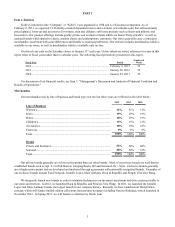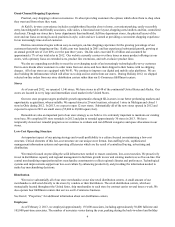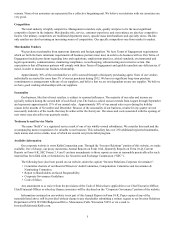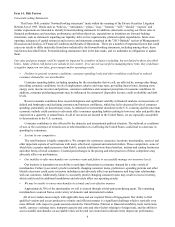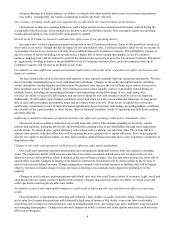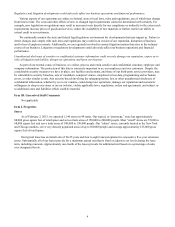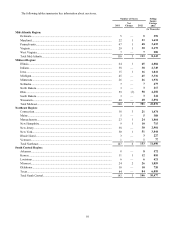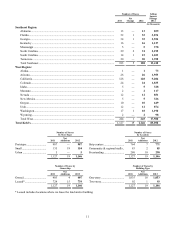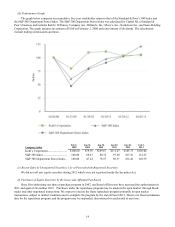Kohl's 2012 Annual Report Download - page 6
Download and view the complete annual report
Please find page 6 of the 2012 Kohl's annual report below. You can navigate through the pages in the report by either clicking on the pages listed below, or by using the keyword search tool below to find specific information within the annual report.6
Item 1A. Risk Factors
Forward-Looking Statements
This Form 10-K contains “forward-looking statements” made within the meaning of the Private Securities Litigation
Reform Act of 1995. Words such as “believes,” “anticipates,” “plans,” “may,” “intends,” “will,” “should,” “expects” and
similar expressions are intended to identify forward-looking statements. In addition, statements covering our future sales or
financial performance and our plans, performance and other objectives, expectations or intentions are forward-looking
statements, such as statements regarding our liquidity, debt service requirements, planned capital expenditures, future store
openings, adequacy of capital resources and reserves and statements contained in the "2013 Outlook" section of Management's
Discussion and Analysis of Financial Condition and Results of Operations. There are a number of important factors that could
cause our results to differ materially from those indicated by the forward-looking statements, including among others, those
risk factors described below. Forward-looking statements relate to the date made, and we undertake no obligations to update
them.
Our sales and gross margin could be negatively impacted by a number of factors including, but not limited to those described
below. Many of these risk factors are outside of our control. If we are not successful in managing these risks, they could have
a negative impact on our sales, gross margin and/or operating results.
• Declines in general economic conditions, consumer spending levels and other conditions could lead to reduced
consumer demand for our merchandise.
Consumer spending habits, including spending for the merchandise that we sell, are affected by, among other things,
prevailing economic conditions, levels of employment, salaries and wage rates, prevailing interest rates, housing costs,
energy costs, income tax rates and policies, consumer confidence and consumer perception of economic conditions. In
addition, consumer purchasing patterns may be influenced by consumers' disposable income, credit availability and debt
levels.
Recent economic conditions have caused disruptions and significant volatility in financial markets, increased rates of
default and bankruptcy and declining consumer and business confidence, which has led to decreased levels of consumer
spending, particularly on discretionary items. A continued or incremental slowdown in the U.S. economy and the uncertain
economic outlook could continue to adversely affect consumer spending habits resulting in lower net sales and profits than
expected on a quarterly or annual basis. As all of our stores are located in the United States, we are especially susceptible
to deteriorations in the U.S. economy.
Consumer confidence is also affected by the domestic and international political situation. The outbreak or escalation
of war, or the occurrence of terrorist acts or other hostilities in or affecting the United States, could lead to a decrease in
spending by consumers.
• Actions by our competitors.
The retail business is highly competitive. We compete for customers, associates, locations, merchandise, services and
other important aspects of our business with many other local, regional and national retailers. Those competitors, some of
which have a greater market presence than Kohl's, include traditional store-based retailers, internet and catalog businesses
and other forms of retail commerce. Unanticipated changes in the pricing and other practices of those competitors may
adversely affect our performance.
• Our inability to offer merchandise our customers want and failure to successfully manage our inventory levels.
Our business is dependent on our ability to anticipate fluctuations in consumer demand for a wide variety of
merchandise. Failure to accurately predict constantly changing consumer tastes, preferences, spending patterns and other
lifestyle decisions could create inventory imbalances and adversely affect our performance and long-term relationships
with our customers. Additionally, failure to accurately predict changing consumer tastes may result in excess inventory,
which could result in additional markdowns and adversely affect our operating results.
• We may be unable to source merchandise in a timely and cost-effective manner.
Approximately 30% of the merchandise we sell is sourced through a third-party purchasing agent. The remaining
merchandise is sourced from a wide variety of domestic and international vendors.
All of our vendors must comply with applicable laws and our required Terms of Engagement. Our ability to find
qualified vendors and access products in a timely and efficient manner is a significant challenge which is typically even
more difficult with respect to goods sourced outside the United States. Political or financial instability, trade restrictions,
tariffs, currency exchange rates, transport capacity and costs and other factors relating to foreign trade, and the ability to
access suitable merchandise on acceptable terms are beyond our control and could adversely impact our performance.



